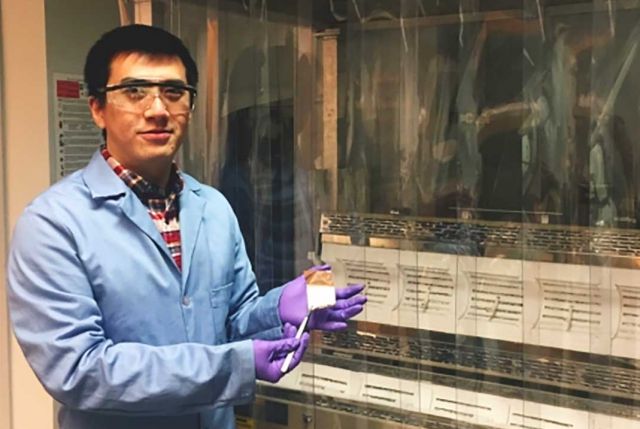Jiang "Significant Impact"
UCSB Electrical Engineer Junkai Jiang and Sociologist Annie Hikido receive 2020 Winifred and Louis Lancaster Dissertation Awards

Each year hundreds of newly minted Ph.D. students graduate from UC Santa Barbara. Of that cohort, some already have made significant methodological and substantive contributions to their fields of study. Among these are students honored with the Winifred and Louis Lancaster Dissertation Awards.
“The completion of a doctoral dissertation is an event worth celebrating in and of itself,” said said Robert Hamm, assistant dean of the Graduate Division. “Beyond the personal achievement, a number of these projects will have significant impact on their respective areas of research.
The competition was tight for the 2020 Lancaster awards, as the Graduate Council reviewed dissertations from some of the brightest minds in mathematics, physical and life sciences, engineering and the social social sciences, all of whom are at the starting line of their research careers.
“The award is a great honor, a celebration of great work accomplished and a vote of confidence of even greater things to come,” said Hamm. “I’m delighted to congratulate the winners and nominees on their accomplishments. They represented the very best of graduate education.”
"Tomorrow’s Tech, Today"
Junkai Jiang recipient for Mathematics, Physical Sciences and Engineering
Ever since his high school days in China, Junkai Jiang has been fascinated by computers and their continuous evolution from power-guzzling room-sized behemoths to smaller, more efficient and sophisticated machines.
“Over the past five decades, computers have become more powerful, smaller and less power-hungry,” he said. “Computers have brought such enormous changes to our everyday lives that few other technologies have.”
Those advances were fueled primarily by miniaturizing components such as transistors and packing them more densely, improving performance without a proportional increase in the energy required, following the well-known axiom known as Moore’s Law — the observation that the number of transistors in a dense integrated circuit doubles about every two years.
But there’s a limit to how small and dense these components can become before physics takes over and they begin to interfere with each other, diminishing functionality. It’s a problem that manufacturers are already facing.
“During the last decade, the semiconductor industry has been confronting a significant problem in the domain of interconnects due to a sharp rise in the resistivity of copper wires as they were made narrower to meet scaling requirements,” Jiang said.
The need to overcome these types of physical limits is the driving force behind Jiang’s research, and his Lancaster Award-winning dissertation, “CMOS-Compatible Doped-Multilayer-Graphene for Next-Generation Interconnects, Passives, and Monolithic-3D Integrated Circuits.”
“It is a genuine technological breakthrough in the practical application of the novel material graphene to integrated circuit design and manufacture, which may very well be the foundation for the next generation of computer chips,” remarked Jiang’s advisor Kaustav Banerjee.
“One of the essential things in research is to find the right problem to solve,” Jiang said. For electrical engineers, finding designs that can meet increasing computer performance demands while maintaining energy efficiency — and in a mass manufacture-friendly fashion — is among the most worthy of challenges.
Enter graphene, a novel material with the potential to become to future electronics what silicon is today to our laptops and cellphones. Only one atom thick, with remarkable electronic properties, graphene has the profile and performance that could be harnessed and designed into a variety of structures, components and architectures.
“By talking to my advisor, who is a pioneer in 2D-based nanoelectronics, senior group members and fellow graduate students, I learned the state-of-the-art technologies and challenges,” Jiang said. He focused his research on exploring the feasibility of novel nanomaterials such as graphene and other 2D materials to bypass the performance degrading effects of tightly packed interconnects (the wires that carry signal from one component in a circuit to another). He also studied the potential for these atom-thick nanomaterials to be designed into ultra-high-density, yet ultimately thin 3D-stacked chips to extend Moore’s Law beyond the current roadmap. He presented at premier conferences to understand key challenges from the industry perspective. The result? According to Banerjee, work that was “already receiving wide recognition in the electronics industry.”
“I was absolutely thrilled to hear the news and particularly pleased to be the third Ph.D. student from our group to win the Lancaster Award,” said Jiang. Now a hardware designer at Google’s Sunnyvale campus, he’s designing chips to accelerate online services, and he looks forward to developing innovative solutions for high-performance, low power electronics using the skills he learned and refined during his time at UC Santa Barbara.
"Over all, I feel I could not have selected a better research group and advisor,” he said. “I was also very well supported by senior group members and department research staff.”
The UCSB Current – "Significant Impact" (full article)